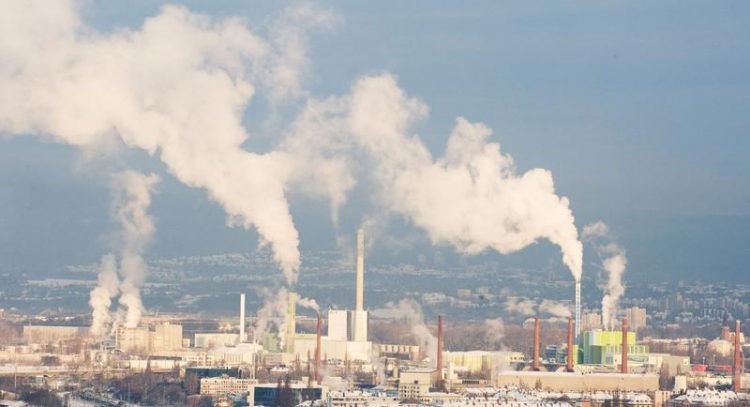Air pollution leads to cardiovascular diseases

Finedust from industry, road and air traffic and agriculture pollutes the air and leads to cardiovascular diseases. Peter Pulkovsky (University Medical Center Mainz)
The large percentage of deaths from cardiovascular disease has prompted an international group of experts from Germany, England and the USA to analyze the negative effects of air pollution on vascular function in a review article.
Key research questions were which components of air pollution (particulate matter, ozone, nitrogen dioxide, carbon monoxide and sulfur dioxide) are particularly damaging to the cardiovascular system and by what mechanisms the vessels are damaged.
“This report in the latest issue of the European Heart Journal is another important contribution from our Working Group on Environment and Cardiovascular Disease. In summary, it can be said that, in relation to the vascular damaging effect of air pollution, particulate matter plays a prominent role”, comments Professor Münzel. “Especially the ultrafine dust makes us very worried.
These particles have the size of a virus. When the ultrafine matter is inhaled, it immediately enters the bloodstream through the lungs, is taken up by the vessels, and causes local inflammation. This ultimately causes more atherosclerosis (vascular calcification) and thus leads to more cardiovascular diseases such as myocardial infarction, acute myocardial infarction, heart failure but also cardiac arrhythmias.
Of particular interest is the fact that with regard to the much-discussed diesel exhaust emissions, particulate matter and not nitrogen dioxide (NO2), both of which are produced by burning diesel fuel, have a negative effect on vascular function”, Münzel continues.
Other participants in the expert group include the world-renowned particulate matter researcher Sanjay Rajagopalan of the Cleveland Clinic, the vascular researcher and cardiologist John Deanfield of the Institute for Cardiovascular Science in London, Univ.- Prof. Dr. Andreas Daiber, Head of Molecular Cardiology of the Mainz University Medical Center and Prof. Dr. Jos Lelieveld from the Max-Planck-Institute for Chemistry (MPIC) in Mainz.
Professor Lelieveld comments: “The fine dust particles are chemically formed mainly in the atmosphere from emissions from traffic, industry and agriculture. In order to achieve low, harmless concentrations, emissions from all these sources need to be reduced.”
“In the future, we will work intensively with the Max-Planck-Institute for Chemistry to investigate the causes of cardiovascular disease caused by air pollution, especially in combination with (flight) noise,” adds Münzel.
Caption: Finedust from industry, road and air traffic and agriculture pollutes the air and leads to cardiovascular diseases.
Use of the photo free of charge with indication of the picture Source: Peter Pulkovsky (University Medical Center Mainz)
Contact
Univ.-Prof. Dr. Thomas Münzel
Department of Cardiology
University Medical Center Mainz
phone 06131 17-5737
E-Mail: tmuenzel@uni-mainz.de
presscontact
Oliver Kreft, Corporate Communications University Medical Center Mainz, Phone 06131 17-7424, Fax 06131 17-3496, E-Mail: pr@unimedizin-mainz.de
About the university medicine of the Johannes Gutenberg University Mainz
The university medical center of the Johannes Gutenberg University Mainz is the only medical institution of the supra-maximum supply in Rhineland-Palatinate and an internationally recognized Science location. It comprises more than 60 clinics, institutes and departments working interdisciplinary. Highly specialized patient care, research and teaching form an inseparable unit in the university medical center Mainz. Around 3,400 students of medicine and dentistry are trained in Mainz. With approximately 7,800 employees, university medicine is also one of the largest employers in the region and an important driver of growth and innovation. More information on the Internet at www.unimedizin-mainz.de
European Heart Journal: https://bit.ly/2OICxkN
Media Contact
All latest news from the category: Ecology, The Environment and Conservation
This complex theme deals primarily with interactions between organisms and the environmental factors that impact them, but to a greater extent between individual inanimate environmental factors.
innovations-report offers informative reports and articles on topics such as climate protection, landscape conservation, ecological systems, wildlife and nature parks and ecosystem efficiency and balance.
Newest articles

Red light therapy for repairing spinal cord injury passes milestone
Patients with spinal cord injury (SCI) could benefit from a future treatment to repair nerve connections using red and near-infrared light. The method, invented by scientists at the University of…

Insect research is revolutionized by technology
New technologies can revolutionise insect research and environmental monitoring. By using DNA, images, sounds and flight patterns analysed by AI, it’s possible to gain new insights into the world of…

X-ray satellite XMM-newton sees ‘space clover’ in a new light
Astronomers have discovered enormous circular radio features of unknown origin around some galaxies. Now, new observations of one dubbed the Cloverleaf suggest it was created by clashing groups of galaxies….





















